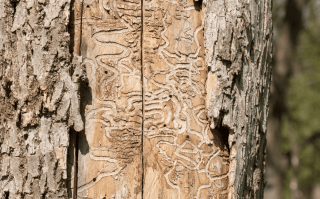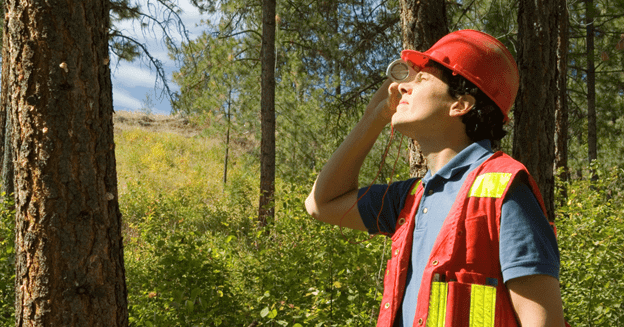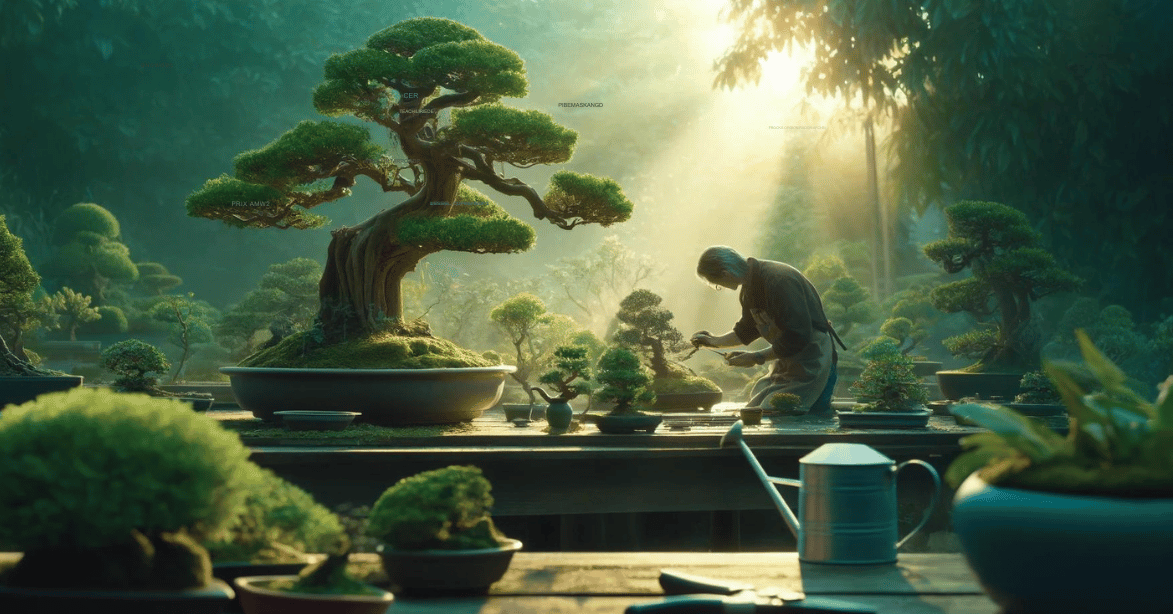Emerald Ash Borer (EAB), an invasive beetle native to Asia, has wreaked havoc on ash trees across North America since its discovery in 2002. With its devastating impact, early detection is crucial for managing and protecting your ash trees. In this article, we will explore the key signs and symptoms that indicate the presence of EAB. By recognizing these indicators, you can take proactive steps to save your valuable ash trees from this destructive pest.
Identification and Life Cycle
The emerald ash borer (EAB) is a small, metallic green beetle that was introduced from China. It first appeared in Southeast Michigan, likely transported in wood from shipping crates. This invasive pest has since spread across North America, attacking ash trees and causing widespread damage.
EAB has a distinct life cycle. Adults emerge in late spring, with peak activity in June or July. They have short antennae and create “D”-shaped exit holes as they leave the tree. The real destruction happens below the bark.
Female beetles lay eggs on the tree, and once they hatch, the creamy-white larvae burrow inside. These larvae have flattened segmented bodies and feed on the tree’s inner layers, cutting off its ability to transport water and nutrients. The larvae remain under the bark through fall and winter before emerging as adults in spring. EAB is most active from May to September, so this is the best time to check for signs of infestation. Early detection can help save your ash trees before it’s too late.
Identification Challenges
Identifying the emerald ash borer (EAB) is tricky because it spends most of its life cycle under the bark of ash trees. By the time visible infestation signs appear, the tree may already be in gradual decline. Unlike other pests that cause immediate damage, EAB works silently, making early insect identification difficult. One key indicator is the presence of “S”-shaped galleries beneath the bark, left behind as larvae feed on the tree’s inner layers. As the pest population grows, the tree struggles to transport water and nutrients, leading to thinning leaves and dead branches.
Biological control efforts, such as releasing parasitoids, help reduce EAB numbers, but they cannot fully stop infestations. Homeowners should regularly check their ash trees for symptoms and consider treatment options before serious tree decline occurs. Understanding the pest’s life cycle and monitoring for early warning signs are crucial to protecting vulnerable tree species from widespread damage.
Mistaken Identity
Not all borers attacking ash trees are the emerald ash borer (EAB). Many native borers, like the banded ash borer and lilac/ash borer, create similar damage, leading to misdiagnosis. This confusion can result in unnecessary treatments or failure to take action when needed. The Minnesota Department of Agriculture and other agencies stress the importance of correct identification to protect trees and prevent the spread of EAB.
One way to distinguish EAB from native borers is by examining the exit holes left in the bark. EAB leaves D-shaped holes, while native borers, like the banded ash borer, create oval or round holes. Checking an emerald ash borer map or an interactive map from forestry programs can help determine if your area is part of an infested county or within quarantined areas. The emerald ash borer program provides guidelines for handling infected trees, particularly in quarantined counties like those near Greater Duluth.
If you suspect an EAB infestation, it’s crucial to confirm the species before removing trees or applying pesticides. Misidentifying native borers as EAB can lead to unnecessary tree loss, while failing to recognize an actual EAB infestation allows it to spread. Use official resources and consult experts to make informed decisions about tree care and management.
Impact and Damage
The emerald ash borer is a destructive, invasive beetle that has devastated ash trees across North America. Once it infests a tree, it burrows into the inner bark and disrupts the nutrient-conducting vessels, cutting off the tree’s ability to transport water and food. Over time, the tree shows clear signs of distress—canopy thinning, dying branches, and cracked bark. As the infestation worsens, D-shaped exit holes appear where adult beetles emerge, leaving behind scars that mark their destruction.
Beyond individual trees, the loss of ash trees has serious ecological benefits at stake. These trees are vital in wet forest habitats, providing shade, stabilizing soil, and supporting wildlife. Without them, the landscape changes, leading to the decline of species that rely on ash for shelter and food. The economic damage is also severe. Ash wood is widely used in furniture, tools, and shipping crates, making industries that depend on it vulnerable. Homeowners and cities face high costs for tree removal and replacement, and the spread continues as people unknowingly move infested firewood to new areas.
Since the beetle has no natural predators in North America, it spreads rapidly. As a wood-boring beetle, it tunnels deep, making early detection difficult. Without intervention, infested trees die within a few years, turning once-thriving forests and neighborhoods into barren landscapes. The best way to slow the spread is to monitor for signs, avoid moving firewood, and seek professional help when an infestation is suspected.
How to Confirm an Infestation
If you see multiple signs, contact a professional arborist. A certified expert can inspect the tree and confirm if EAB is present. Early diagnosis is key to saving your tree.
"S" Shaped Galleries: A Telltale Sign
One of the most distinctive signs of an Emerald Ash Borer infestation is the formation of "S" shaped galleries beneath the bark. The EAB larvae create these galleries as they feed on the tree's inner layer, the cambium. Over time, the tunnels widen, forming these winding, serpentine patterns.
To check for "S" shaped galleries, carefully peel a piece of the tree's bark back. However, remember that this should be done cautiously, as excessive damage to the tree can weaken it further. If you observe these galleries, it's a clear indicator of an EAB infestation and warrants immediate attention.
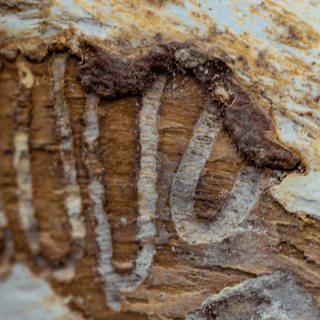
Woodpecker Damage
Woodpeckers are natural predators of EAB larvae. They peck at the bark to access the larvae beneath when they detect an infestation. Thus, an increase in woodpecker activity on your ash tree can indirectly indicate EAB presence.
While woodpecker damage can be beneficial in controlling the pest population, it also indicates a severe problem. Frequent and extensive woodpecker activity on your ash tree is an apparent reason to inspect it for EAB infestation.

Crown Thinning
As EAB larvae feed on the cambium layer, the tree's ability to transport nutrients and water is severely impaired. This results in crown thinning, where the tree's upper branches begin to lose their foliage. This phenomenon can be observed from a distance as the tree's canopy becomes increasingly sparse.
Crown thinning is a visual cue that the tree is struggling to survive. If you notice your ash tree's canopy becoming sparser, it's essential to investigate further for EAB infestation.
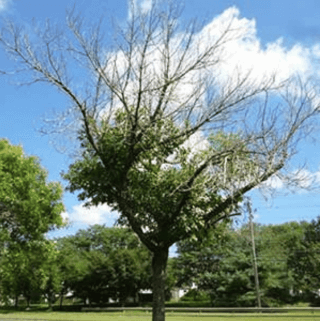
"D" Shaped Exit Holes
Adult Emerald Ash Borers exit the tree after completing their larval stage, leaving behind distinctive "D" shaped exit holes. These exit holes are about 1/8 inch in diameter and are typically found on the tree's trunk and branches. These small, D-shaped holes are a definitive sign of an EAB infestation.
When inspecting your ash tree, pay close attention to the trunk and branches for these exit holes. If you find them, taking immediate action to address the infestation is vital.

Bark Splitting
The tree's bark may split vertically as the Emerald Ash Borer infestation progresses. This splitting is often accompanied by other signs like "S" shaped galleries and D-shaped exit holes.
Bark splitting weakens the tree's structural integrity and provides an entry point for other pests and diseases. If you observe bark splitting on your ash tree, it's crucial to assess and address the issue promptly.
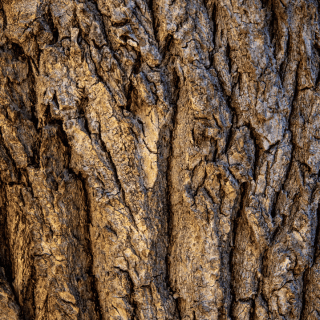
Epicormic Sprouts
Epicormic sprouts are small shoots that emerge from the trunk or branches of a tree in response to stress. When an ash tree is under duress due to an EAB infestation, it may produce these sprouts to compensate for the loss of canopy foliage.
While epicormic sprouts may seem like a sign of recovery, they indicate severe stress and a weakened tree. They should not be mistaken for a healthy growth response. Instead, they signal the urgent need for professional intervention to save the tree.
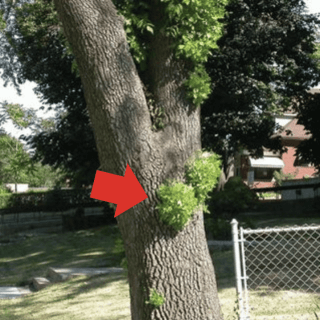
Look-Alike Species: Don’t Mistake These Insects for Emerald Ash Borer
Not every beetle in your ash tree is the emerald ash borer (EAB). Many native borers look similar but don’t cause the same level of destruction. Misidentifying pests can lead to unnecessary tree removal or mistreatment. Some of the most common emerald ash borer look-alikes include the banded ash borer and the lilac/ash borer. These native borers tend to infest already weakened trees, while EAB attacks healthy ones.
One key difference is the exit holes. EAB creates distinctive D-shaped holes, while other borers often leave round or oval openings. If you see S-shaped galleries under the bark, that’s a strong sign of EAB activity. However, before debarking ash tree logs to check for damage, it’s best to consult a certified arborist. Proper identification methods, like using a trapping materials list and following approved trapping protocols, help experts confirm infestations.
Survey data spreadsheets and interactive story maps track EAB spread and help with early detection. If you're unsure whether your tree is infested, professional trapping and inspection can provide clear answers. Identifying pests correctly can mean the difference between saving a tree and losing it to the wrong treatment.
Reporting and Monitoring
Tracking the emerald ash borer (EAB) is critical to slowing its spread. If you spot signs of an infestation, report it immediately to local forestry or agricultural authorities. Detection surveys help experts confirm EAB locations in Iowa and other affected areas. Officials use an emerald ash borer infestation time series spread map to monitor how quickly the beetle moves across counties. By following emerald ash borer trapping guidelines, specialists set traps in high-risk areas to detect new outbreaks.
One method for studying infestations is debarking ash tree logs to check for larvae. This process reveals the extent of damage beneath the bark. Researchers also rely on a survey data spreadsheet to track new reports and update the emerald ash borer known infested counties list.
To control the beetle, scientists are testing EAB biological control methods. This includes the proposed release of three parasitoids—tiny wasps that prey on EAB larvae. These efforts are mapped using a biocontrol release map, which shows where these natural enemies have been introduced.
Public awareness plays a key role. Trapping protocols and detection surveys help authorities gather data, but stopping EAB requires public outreach and education. Homeowners can help by learning to identify signs of infestation and avoiding the movement of ash wood. The more people report and monitor, the better chance we have of protecting ash trees for future generations.
Management and Control
Managing and controlling the emerald ash borer (EAB) requires a combination of methods to protect ash trees and slow the spread of the infestation. Early detection is key. Detection surveys help locate affected areas, allowing communities to take action before severe damage occurs. The Minnesota Department of Agriculture and other organizations provide trapping guidelines to monitor EAB populations and track their movement.
One effective strategy is integrated pest management, which combines multiple techniques for long-term control. This includes removing and debarking ash tree logs to destroy larvae hiding beneath the bark. In some areas, EAB biological control has been introduced using natural predators like Parasitoid Spathius galinae, a tiny wasp that targets EAB larvae. While biological control can reduce beetle populations, it works best as part of a broader management plan.
For homeowners and cities, insecticide options are available to protect trees. Only a certified pesticide applicator should apply these treatments, as improper use can harm beneficial insects. Preventive treatments are most effective on healthy ash trees before an infestation takes hold.
Local governments and tree care professionals emphasize public outreach and education to raise awareness about EAB risks. Programs focus on community preparation, encouraging people to avoid moving firewood and report suspected infestations. Managing EAB is a group effort. By staying informed and following expert recommendations, communities can help protect their ash trees from this destructive pest.
Contact Strobert Tree Services: Your Ash Tree Preservation Partner
If you suspect that your ash tree may be infested with Emerald Ash Borers or if you've identified any of the signs mentioned in this article, it's essential to take action promptly. Contacting certified arborists like Strobert Tree Services can make all the difference in preserving your valuable ash trees.
We are a team of Delaware arborists with extensive experience in tree care, including diagnosing and treating EAB infestations. Our expertise can help determine the extent of the infestation and recommend appropriate treatment or tree removal, if necessary.
Protecting your ash trees from Emerald Ash Borers requires vigilance and proactive measures. By staying informed about the signs of infestation and seeking professional assistance when needed, you can contribute to preserving these vital trees in our environment.


